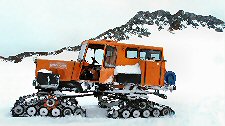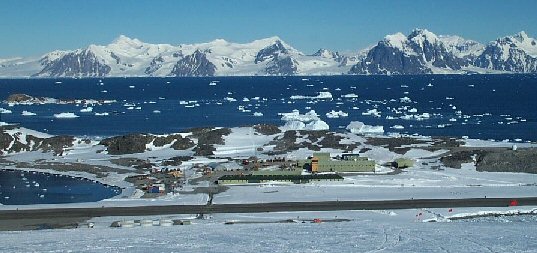Chapter
Three - Rothera Arrival
Still
not 100% convinced we were actually going to fly, after all the day before we'd
packed bags & got on the minibus to the airport only to be told there was,
yep, another problem, we walked across the apron & boarded the BAS Dash
7 & joined the crew for the trip to Rothera.
The
flight, depending on the weather, is in the order of 5 hours or so, unfortunately
the weather this time wasn't the best so the views were a bit limited however
the sight of the snow covered peaks rising above the clouds as we flew down
the Antarctic peninsula was pretty amazing.
As
we dropped through the clouds you could still see plenty of pack ice about &
as we desended towards Rothera the Laubeuf Fjord was frozen solid as far as
the eye could see apart from the path cut through the ice in Marguerite Bay,
apparently where the american research vessel, the R/V Laurence M.Gould, had
approached several days earlier.
Stepping
off the Dash your senses were immediately assaulted by whole presence of the
place, it was, well, simply awesome. Stunned, we were greeted by the summer
base commander, Steve Hinde, I'd met Steve briefly at BAS headquarters at Cambridge
some months earlier, seeing him kitted out for the Antarctic however was just
a bit surreal.
 As I was going to be calling Rothera home for the next five months or so I thought
I'd better get to know the place. Adelaide Island, on which Rothera Research
Station is sited, was first sighted from the brig “Tula” in February 1832 when
completing a circumnavigation of the Antarctic continent. John Biscoe, the ship's
master, named the land after Queen Adelaide the wife of British monarch King
William IV. In 1909 a French doctor named Jean Baptiste Charcot led the crew
of the yacht “Pourquoi Pas” on a voyage down the west coast of the Antarctic
Peninsula. His expedition named many of the features they could see from Marguerite
Bay. It was not however until the British expedition of Graham Land in the mid
1930's that Adelaide was confirmed to be an island separate from the Antarctic
Peninsula.
As I was going to be calling Rothera home for the next five months or so I thought
I'd better get to know the place. Adelaide Island, on which Rothera Research
Station is sited, was first sighted from the brig “Tula” in February 1832 when
completing a circumnavigation of the Antarctic continent. John Biscoe, the ship's
master, named the land after Queen Adelaide the wife of British monarch King
William IV. In 1909 a French doctor named Jean Baptiste Charcot led the crew
of the yacht “Pourquoi Pas” on a voyage down the west coast of the Antarctic
Peninsula. His expedition named many of the features they could see from Marguerite
Bay. It was not however until the British expedition of Graham Land in the mid
1930's that Adelaide was confirmed to be an island separate from the Antarctic
Peninsula.
From
1955 to 1960 the UK maintained a survey station on Horseshoe Island on the east
side of Marguerite Bay but in 1957 two surveyors John Rothera and Peter Gibbs
crossed the frozen sea ice and explored the area now known as Rothera Point.
From 1961 to 1977 UK activity in the area was conducted from Adelaide Island
Station located at the southern tip of the island.
For
many years this proved a good base from which to undertake further survey of
the Antarctic Peninsula Rothera Station was established in 1975 to replace Adelaide
Island Station where the glacier ski way had deteriorated rendering the operation
of ski equipped aircraft hazardous. There was a phased construction programme
so that by 1980 the station provided accommodation, electrical power generation,
vehicle workshops, scientific offices and a store for travel equipment. 
From
Rothera’s inception through to the early 1990's austral summer season BAS's
Twin Otter aircraft used a glacier ski way some 300m above the station on the
Wormald Ice Piedmont. During that summer a 900m crushed rock runway and hangar
facility was commissioned bringing a more reliable air operation and the possibility
of a passenger aircraft link from outside the continent.
Up until that time everyone coming to Rothera had to depart from the Falkland
Islands by ship, with the coming of the runway Rothera became the hub of BAS's
logistical Antarctic network. The development of the Rothera site continues,
hence my presence, the works ongoing however are not an expansion of the station
but an ongoing programme of replacing old structures making best use of new
technologies, improved insulation & energy production as well as management
systems to further reduce the environmental footprint of the station.
So,
having dumped my kit in Admirals House I & the other new arrivals were given
a quick tour of the main facilities & fed following which a couple of us
pursuaded Antarctica regular Crispin to walk us around Rothera Point, as said
elsewhere the waters around the station were still ice covered when we arrived
so it was could to be shown just where the land ended before being let loose
by ourselves.
 After
being escorted around the Point, the next day we were bundled into one of the
station's Sno Cat & taken up the Ramp & along Reptile Ridge to the caboose
at Val's, looking back across the station to the mountain ranges beyond it really
did put things in context, it was very, very humbling.
After
being escorted around the Point, the next day we were bundled into one of the
station's Sno Cat & taken up the Ramp & along Reptile Ridge to the caboose
at Val's, looking back across the station to the mountain ranges beyond it really
did put things in context, it was very, very humbling.
The
first couple of days were spent digging out the site & setting up the site
for the coming months however with near 24hr daylight there was plenty of time
after work to get to know the surrounding enviroment. From the very start, &
my opinion hasn't changed, it was an absolute privilege to be there, the scenery
changed every day, vast ice bergs came & went, bloody fantastic.

So,
what did I do for the next five or so months, work bloody hard, but thats not
what this page is about, its about the bits in between. there wasn't too many
of those but you do what you can when you can.
Back
to Antarctica

 As I was going to be calling Rothera home for the next five months or so I thought
I'd better get to know the place. Adelaide Island, on which Rothera Research
Station is sited, was first sighted from the brig “Tula” in February 1832 when
completing a circumnavigation of the Antarctic continent. John Biscoe, the ship's
master, named the land after Queen Adelaide the wife of British monarch King
William IV. In 1909 a French doctor named Jean Baptiste Charcot led the crew
of the yacht “Pourquoi Pas” on a voyage down the west coast of the Antarctic
Peninsula. His expedition named many of the features they could see from Marguerite
Bay. It was not however until the British expedition of Graham Land in the mid
1930's that Adelaide was confirmed to be an island separate from the Antarctic
Peninsula.
As I was going to be calling Rothera home for the next five months or so I thought
I'd better get to know the place. Adelaide Island, on which Rothera Research
Station is sited, was first sighted from the brig “Tula” in February 1832 when
completing a circumnavigation of the Antarctic continent. John Biscoe, the ship's
master, named the land after Queen Adelaide the wife of British monarch King
William IV. In 1909 a French doctor named Jean Baptiste Charcot led the crew
of the yacht “Pourquoi Pas” on a voyage down the west coast of the Antarctic
Peninsula. His expedition named many of the features they could see from Marguerite
Bay. It was not however until the British expedition of Graham Land in the mid
1930's that Adelaide was confirmed to be an island separate from the Antarctic
Peninsula.
 After
being escorted around the Point, the next day we were bundled into one of the
station's Sno Cat & taken up the Ramp & along Reptile Ridge to the caboose
at Val's, looking back across the station to the mountain ranges beyond it really
did put things in context, it was very, very humbling.
After
being escorted around the Point, the next day we were bundled into one of the
station's Sno Cat & taken up the Ramp & along Reptile Ridge to the caboose
at Val's, looking back across the station to the mountain ranges beyond it really
did put things in context, it was very, very humbling.